One of the biggest threats to D-Day success came from the Allied side—with the shortage of a key ship
[dropcap]S[/dropcap]EVENTY-FOUR YEARS AFTER THE ALLIED LANDINGS in Normandy on June 6, 1944, it is easy to regard the successful invasion of German-occupied France as preordained, its outcome a matter of the inevitable triumph over Nazism.
It was not. Instead, due to a logistical bottleneck involving a very particular kind of ship, Operation Overlord was postponed and very nearly halted in its tracks. The culprit was a little-appreciated and seldom-admired type of naval craft known as the Landing Ship, Tank, or LST—the shortage of which very nearly upset the entire operation.
The irreverent sailors who manned these curious ships sarcastically claimed that the acronym actually stood for “Large Slow Target.” They were not entirely wrong. At over 300 feet in length, LSTs were indeed large and, with a maximum speed of 10 knots, slow as well. Moreover, their prominence at amphibious landings made them prime targets. They were also remarkably hard to navigate. With their blunt bows (which one LST sailor called “a horrible snow-shovel snout that cannot cut the water”), shallow draft, and flat bottoms, they thumped down jarringly on every wave. Even in relatively mild waters LSTs induced near-universal seasickness not only among the embarked soldiers, but among the crew. As an LST veteran recalled, the ships “stank of diesel oil, backed-up toilets, and vomit.”
For all that, LSTs were the vital component in Allied amphibious landings from the Mediterranean to the Central Pacific. They could steam up onto a beach, open their bow doors, deploy a short ramp, and deposit wheeled or tracked vehicles directly onto the sand. Operational commanders found them useful for other types of missions as well, from transporting personnel and vehicles to providing floating stowage.
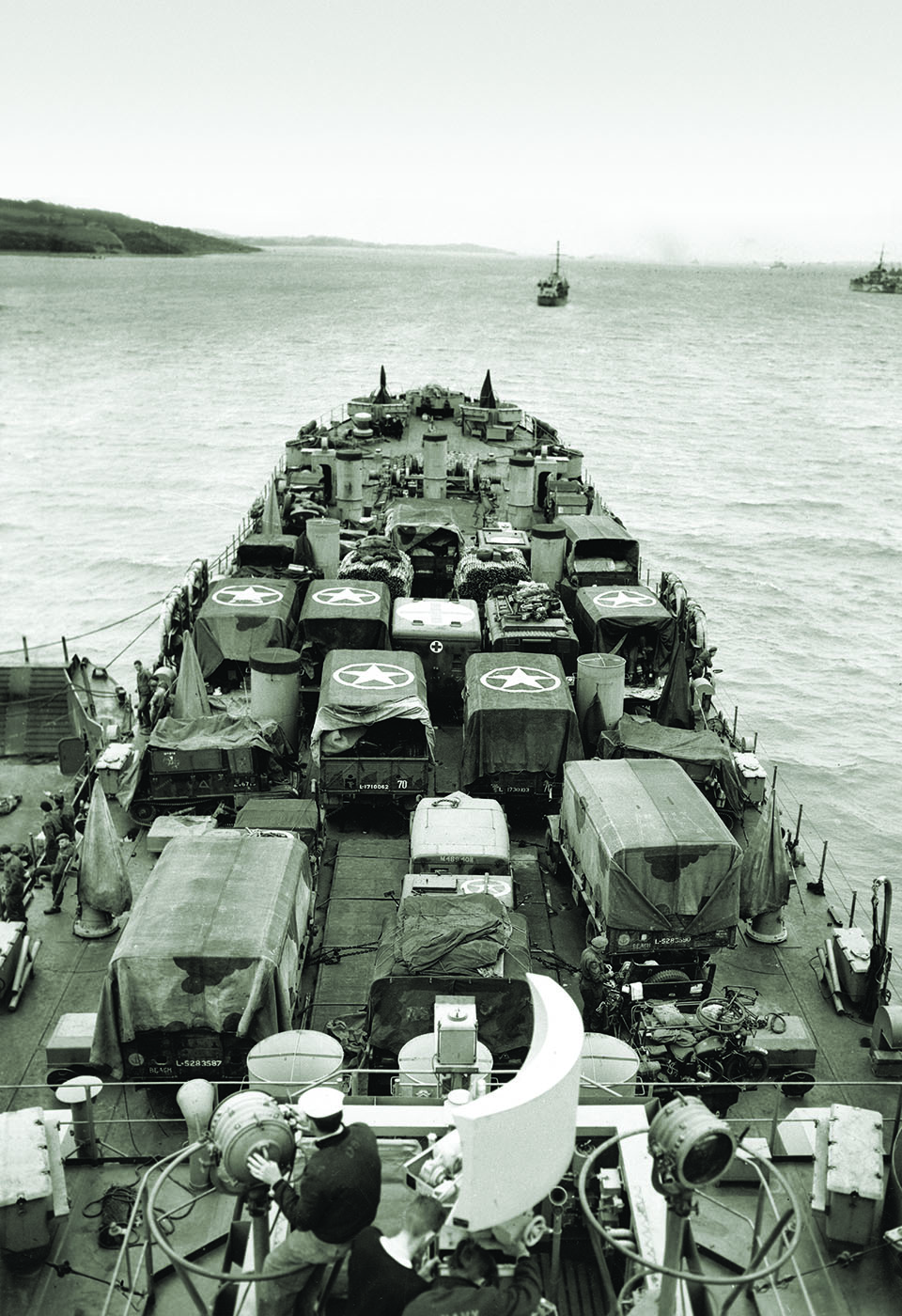
The problem was there were simply not enough of them. Despite America’s astonishing industrial productivity, circumstances conspired to create a shortage of these essential vessels at a critical moment in the war.
IN 1942 THE WAR PRODUCTION BOARD, established by President Franklin D. Roosevelt to supervise war mobilization, made LSTs the highest priority in the American wartime construction program. Soon after the Operation Torch landings in North Africa that November, however, the Battle of the Atlantic was nearing its climax and the board elevated the production of destroyer escorts to the top of the list, dropping LSTs to 12th place, behind minesweepers.
The decision turned out to be the right one: the new escorts helped turn the tide in the Battle of the Atlantic. With the German U-boat menace under control (if not entirely suppressed) by late spring 1943, the Allies sought to reinvigorate the LST program. The U.S. government ordered four American shipyards that had been reconfigured to build destroyers to shift back to the construction of Liberty ships and LSTs.
Retooling a shipyard, however, is not a matter of simply throwing a switch. More than 30,000 parts went into the construction of one LST, and recreating such a lengthy supply chain took time. On top of that, the LST construction program competed with other accession programs. In particular, there was fierce competition for steel plates, needed not only for ship construction, but for tanks, airplanes, and, indeed, almost all weapons of 20th-century warfare.
Most LSTs were constructed at so-called “cornfield shipyards” along the Ohio and Illinois Rivers, which collectively produced an average of 24 new LSTs each month. Impressive as that was, this fell well-short of the need. In September 1943 the Allies employed 90 LSTs to invade Salerno, south of Naples on the coast of Italy; both Admiral Chester Nimitz and General Douglas MacArthur needed at least that many more in the Pacific; and casting a giant shadow over all theaters was the pending invasion of northern France—Operation Overlord—officially scheduled for May 1, 1944, and requiring 230 LSTs.
By late 1943 a shortage of LSTs had become the single greatest impediment to the fulfillment of Allied ambitions. This became starkly evident during the Italian Campaign.
INITIALLY HITLER HAD NOT PLANNED to defend southern Italy once the Allies successfully gained a foothold on the peninsula; due to the Allies’ naval superiority, it was obvious an amphibious landing could easily outflank any Axis defensive position there. However, the Führer changed his mind after his Mediterranean Theater commander, Field Marshal Albert Kesselring, mounted a robust defense of the beaches at Salerno. Soon after, Kesselring established a strong defensive position some 50 miles north of Naples that ran across the width of Italy.
The precise location of this line accommodated the shifting fortunes of war, and its several versions had various names: the Winter Line, the Hitler Line, and, most often, the Gustav Line. It consisted of an interlocking network of pillboxes, bunkers, and minefields anchored on the small Italian town of Cassino, overlooked by a Benedictine abbey known as Monte Cassino. When the Allies broke out from Salerno in September 1943 and collided with this heavily fortified position, they came to an abrupt halt. Almost at once the idea of outflanking the Gustav Line with an amphibious end run became a prominent element of Allied planning.
The problem was that a landing behind the Gustav Line would require the use of more than three-score LSTs already scheduled to go to England for the invasion of Normandy. If the operation could be done quickly, the LSTs might be able to do both—though that would work only if they could be released from the Mediterranean soon after the initial landing.
Newly appointed Supreme Allied Commander General Dwight D. Eisenhower, who was scheduled to go to England in a few weeks to assume command of the cross-Channel invasion, thought such an end run was worth consideration. He asked the Combined Chiefs of Staff for permission to keep 56 British and 12 American LSTs in the Mediterranean until January 15, 1944. That would enable him to land one Allied division at Anzio, 70 miles behind the Gustav Line, which—in conjunction with a breakthrough by Lieutenant General Mark W. Clark’s U.S. Fifth Army near Cassino—would overthrow Kesselring’s defenses. The plan had a short life, however, for it soon became evident that a swift breakthrough at Cassino, where Allied forces beat their heads fruitlessly against the German defenses, was unlikely, and the idea was shelved.
It was Winston Churchill who revived it.
At the Tehran Conference of November 28 to December 1, 1943, where Churchill, Roosevelt, and Stalin met face to face for the first time, the British prime minister argued passionately for extending the campaign in the Mediterranean to Rome and beyond. His pleas met stern and unyielding opposition from both the Americans and the Russians, who saw it as yet another effort by the British to delay or postpone the Normandy Invasion. Churchill was undeterred. He found the stalemate at Cassino “scandalous” and continued to hope that he could somehow engineer a decisive Allied victory in Italy. He even imagined that a dramatic success there might make the Normandy landings unnecessary.
Churchill remained in the theater after the Tehran Conference, which strengthened his ability to influence military operations there. That he did so was more a product of chance than intrigue. The conference at Tehran had so exhausted him that he contracted pneumonia, and on his doctor’s orders remained in North Africa—first at Tunis, then at Marrakesh—to recover. Nevertheless, this allowed him to attend, and even to dominate, planning sessions for the Mediterranean.
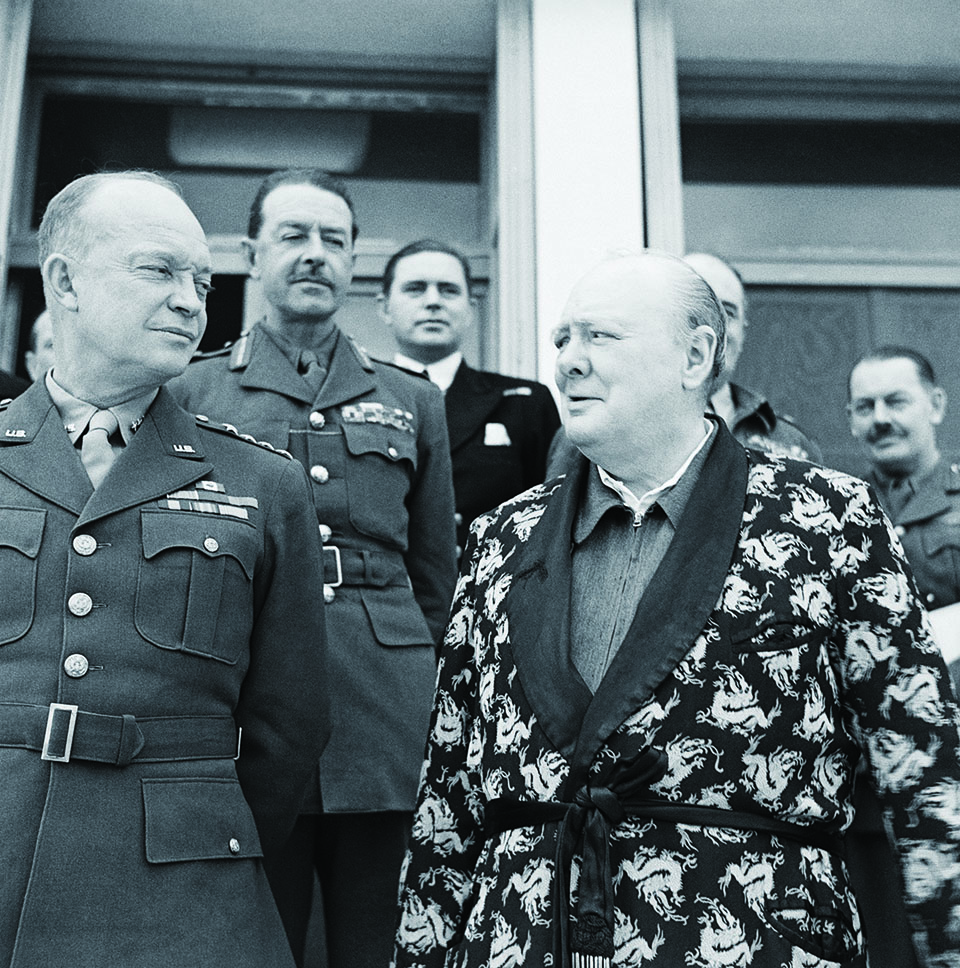
The decisive meeting took place in Tunis on Christmas Day 1943. It was then that Churchill beguiled his military commanders with a vision of the inevitable success that would result from outflanking the Gustav Line by sea—a move that the prime minister, whose vocabulary had not been enriched by American football terms, called not an “end run” but a “cat’s paw.” The move would greatly threaten the German supply line, he insisted, forcing Kesselring to respond in one of two ways: Either he must weaken his defenses at Cassino to protect his supply line, which would allow Allied armies to smash through the Gustav Line, or he must retreat entirely.
Churchill’s influence became all the stronger in January 1944, when Eisenhower departed for England to command Overlord, leaving the theater in the hands of an all-British command team. General Henry Maitland Wilson (called “Jumbo” in tribute to his girth) took over as theater commander; General Harold Alexander remained in command of the ground forces; and Sir John Cunningham commanded the naval forces.
Whereas Eisenhower had considered a breakthrough at Cassino important to landing at Anzio, Churchill’s vision was that the landing itself would open the road to Rome. To ensure its success, commanders expanded the landing force from one division to two.
Of course that also meant keeping even more LSTs in the Mediterranean—and for a longer period. Churchill did not see this as a serious problem. Impatient as he was with logistical details, he argued that this was a mere inconvenience. (As U.S. Secretary of War Henry L. Stimson put it in his diary, Churchill had “a mind which revolts against the hard facts of logistics.”) In addition, however, Churchill also noted that because the crews of the LSTs in the Mediterranean were veterans of previous landings at Sicily and Salerno, they did not need the kind of training and rehearsals that the new LST crews coming from America required. Because of that, he insisted that the 68 LSTs needed to land a flanking force at Anzio could remain in the Mediterranean an extra month—until February 15, 1944—and still get back to England in time for the cross-Channel invasion in May.
To make it work, timing was critical. The Anzio landing was set for January 20, 1944, and the LSTs would have to depart for England no later than three weeks after that. That should have been a sufficient margin of error—and it likely would have been if Kesselring had behaved as Churchill predicted.
Churchill was confident that the battle would be decided “in a week or ten days,” though some of his operational commanders were less sure. Alexander wrote him that it would be unconscionable to leave two divisions marooned on the Italian coast without support from the sea, and insisted that 14 of the LSTs stay behind under any circumstances “for maintenance.” For his part, Cunningham told Churchill that the operation was “fraught with great risks,” a concern that Churchill waved off with the comment, “without risk there is no honor.”
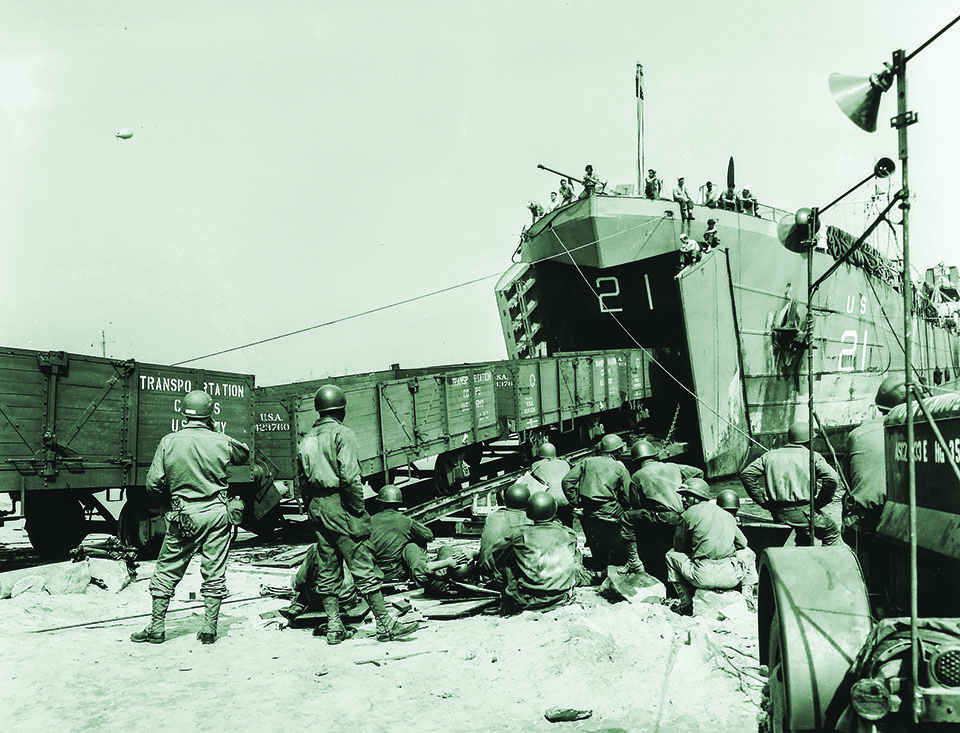
THE BATTLE GOT OFF TO AN AUSPICIOUS start, with the Allied landings at Anzio achieving complete surprise. By midmorning, all of the first day’s objectives had been seized and the Allies held an enclave 15 miles wide and 7 miles deep.
In a decision that has been much criticized since, the Allied ground commander, American Major General John P. Lucas, did not immediately advance inland, either northward toward Rome or eastward to cut the roads that led to the German defenses at Cassino. His orders indicated that his primary assignment was to establish a strong beachhead—the very existence of which, he had been assured, would compel the Germans to fall back. Because of that, Lucas established a strong perimeter and focused on getting the harbor at Anzio into a state of repair to receive more men and supplies. By the end of the first day, the LSTs and transports had successfully landed 36,000 men and 3,200 vehicles at Anzio with few casualties.
Surprised as he was, though, Kesselring did not consider a retreat. He believed he could hold the Gustav Line and pin down the Allies at Anzio. Rather than withdraw forces from Cassino, Kesselring brought two reserve divisions from Rome and summoned additional forces from Yugoslavia and France. Within days he had concentrated elements of eight divisions around the Allied enclave without weakening his forces on the Gustav Line.
General Clark’s Fifth Army hammered away at that line, but with little success, and as a result there was no link up between Clark’s army and Lucas’s two divisions at Anzio. The Germans thus held an interior position between two Allied fronts and were able to choose where to defend and where to attack.
Kesselring decided to attack Lucas. On the last day of January, he sent columns of tanks and infantry against the Allied enclave (which Hitler called an “abscess”) in an effort to drive the invaders back into the sea. The Allied lines bent under these sustained blows, but they did not break.
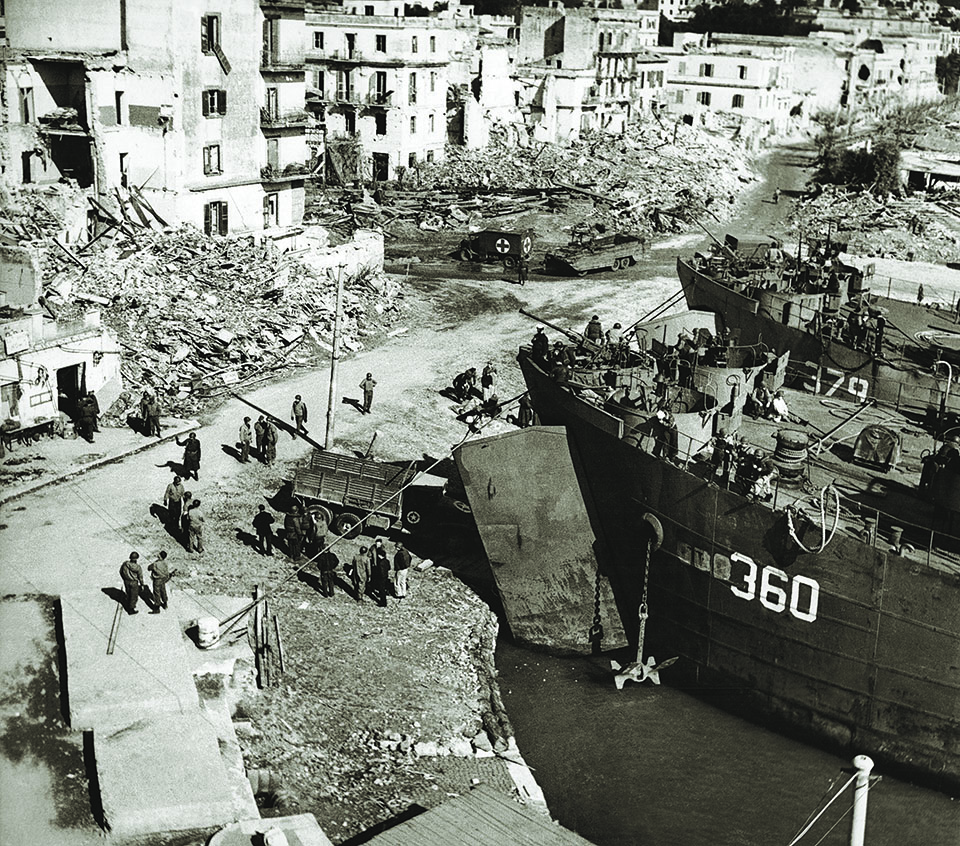
In addition to hard fighting ashore, one reason the Allies held fast was that the LSTs and other supply ships brought in a contin-uous flow of fresh troops and supplies. Throughout February 1944, convoys of LSTs left Naples every day carrying reinforcements plus trucks loaded with food, gear, and ammunition. When they arrived at Anzio, the men disembarked and the loaded trucks drove ashore. Other trucks filled with Allied wounded and Axis POWs took their place, and the LSTs retracted from the beach to head back to Naples to repeat the process.
The LST crews labored around the clock. They were either loading, unloading, or underway virtually all of the time, and while doing so, were almost always under air attack. Theodore Wyman, the first lieutenant on LST-197, recalled that, “We were so damnably tired that we just didn’t have time to be bothered about being tired.” Soon enough the LSTs began sending crewmen ashore at Naples who were afflicted with “combat fatigue” and “shell shock,” terms then used to describe posttraumatic stress disorder. After the war Wyman asserted that of the five operations his ship participated in from North Africa to Normandy, “it was the Anzio Campaign that took the most out of us.” But the supplies got through, and, because they did, the Allies at Anzio held on.
Of course holding on had never been the objective. Churchill was frustrated and distraught that his cat’s paw had failed to open the road to Rome. An operation that was supposed to end the stalemate and enable Allied soldiers to charge up the Italian boot had instead turned into yet another bloody battle of attrition.
THE IMPACT OF THIS DISAPPOINTMENT rippled throughout the European Theater. When Eisenhower arrived in England to take up his new assignment as Supreme Allied Commander, he already knew that the lack of LSTs would pose a critical problem, even without the added pressure of sustaining the Anzio beachhead. British Major General Frederick E. Morgan, who had led the team that compiled the original plan for Overlord, had based all his calculations on a three-division assault, mainly because he had been told by the Combined Chiefs of Staff there would be sealift sufficient for only three divisions.
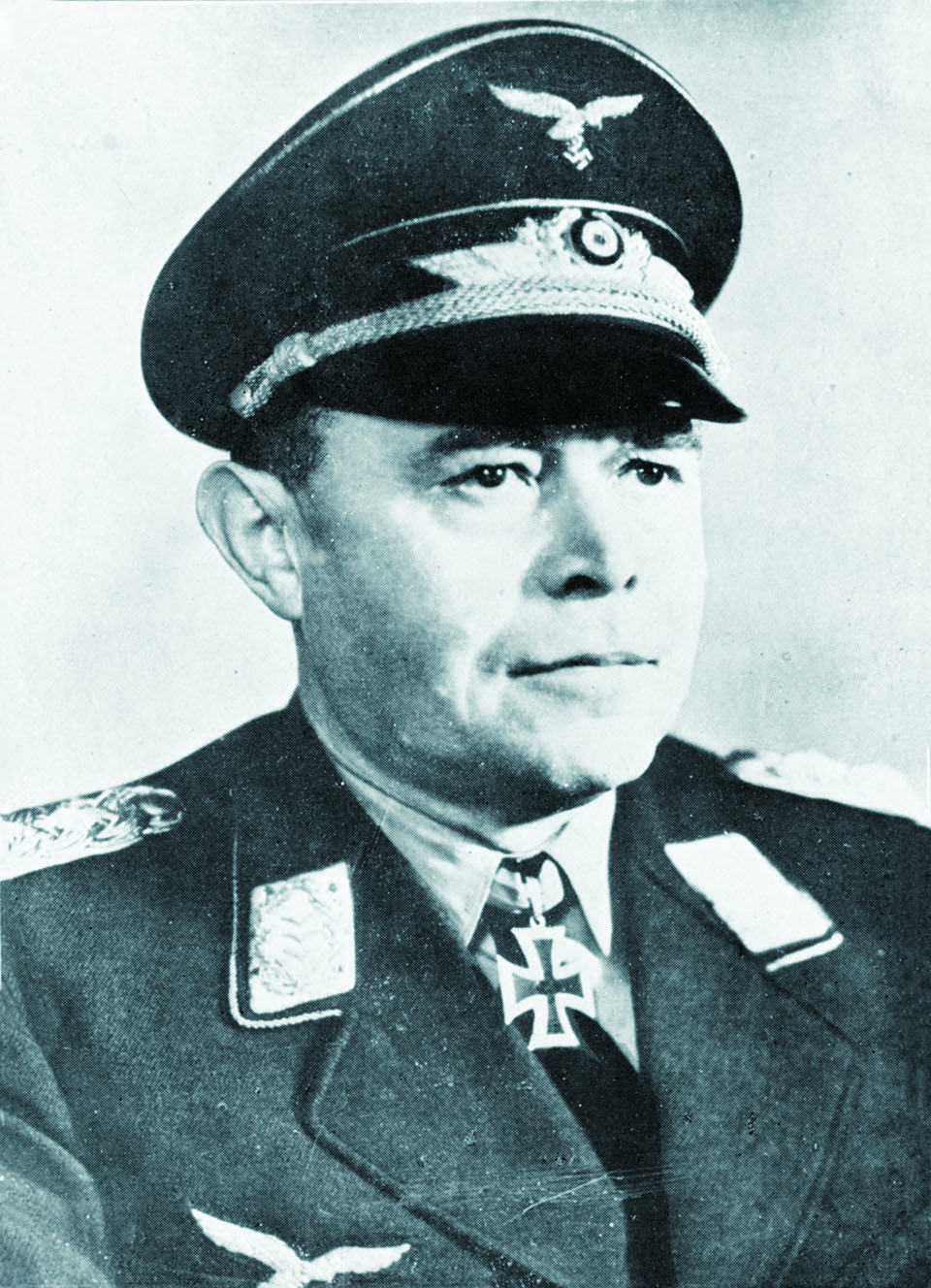
From the start, however, Eisenhower knew that three divisions would not be enough to break through Hitler’s Atlantic Wall. After all, he had used seven divisions to invade Sicily. He therefore directed that the plan be rewritten to accommodate a five-division sea assault plus two airborne divisions. That meant a dramatic expansion of landing craft—in particular the all-important LSTs. On January 23, the day after Lucas’s two divisions went ashore at Anzio, Eisenhower wrote the Combined Chiefs in Washington to insist that in addition to the 230 LSTs Morgan had called for, he needed 47 more.
Grudgingly accepting Eisenhower’s math, the Joint and Combined Chiefs sought some way to direct LSTs to England from other theaters. Eisenhower suggested that perhaps the LSTs in the Mediterranean could be replaced by attack transports so the LSTs there could be sent to England for Overlord.
The Joint Chiefs had a different suggestion. They proposed sending 26 new LSTs from the United States to the Mediterranean, if theater commander Jumbo Wilson agreed to send 26 of those he now had to England. Quite reasonably, Wilson wondered why it would not be easier simply to send the 26 new LSTs directly to England. Only then did the Joint Chiefs reveal that the new LSTs in question were still on the building ways and would not be available until the end of May. That would make their arrival too late for Overlord, though as far as Wilson was concerned, it made them too late for the defenders of Anzio as well.
There was no escaping the numbers. Without additional LSTs, Eisenhower would not have enough to sustain the invasion force at Normandy. He wrote to army chief George C. Marshall that while there would be enough LSTs for the first three tides; after that, “we will have no repeat no LSTs reaching the beaches after the morning of D plus 1 until the morning of D plus 4.” In other words, the Allied invasion force would be stranded on the Normandy beaches for three days without the means to reinforce, resupply, or evacuate—an unacceptable outcome.
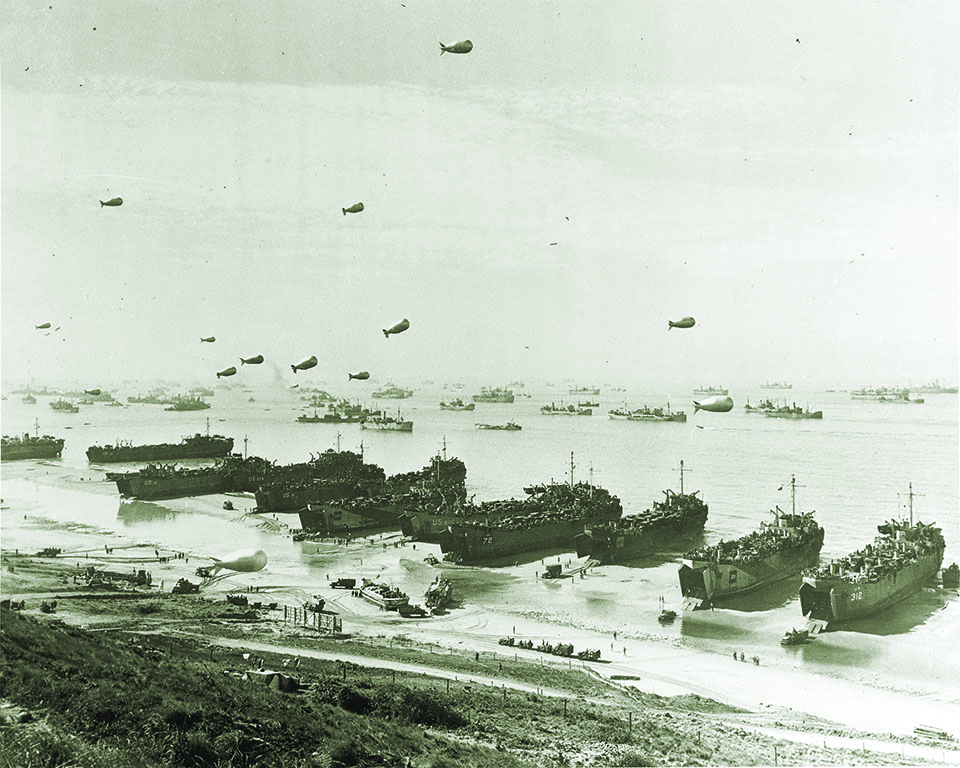
The solution was two-fold. First Allied planners postponed the date for Overlord by a month, from the first week of May to the first week of June. That would provide American shipyards extra time to build as many LSTs as possible. As Eisenhower wrote to Marshall, “one extra month of landing craft production, including LSTs, should help a lot.” Second, they decided to postpone the planned simultaneous landing in southern France, called Anvil. Eisenhower was less pleased by this decision, as he had counted on the landings in southern France to distract the Germans from the Overlord landings. “It looks like ANVIL is doomed,” he wrote in his diary on March 22. “I hate this.”
In the end, the delays gave Eisenhower just enough LSTs to carry out Overlord, but it was a near-run thing. Churchill’s enthusiasm for the Italian “cat’s paw,” and his overly optimistic assumptions about how the enemy would behave in reaction to it, postponed and very nearly derailed the greatest operation of the war. The Allies did eventually break out of the Anzio beachhead and advance on Rome. American troops entered the Eternal City on June 4.
Two days later other Allied forces landed in Normandy. ✯
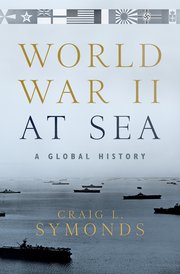 Adapted from WORLD WAR II AT SEA: A Global History by Craig L. Symonds. Copyright © 2018 by Craig L. Symonds and published by Oxford University Press. All rights reserved.
Adapted from WORLD WAR II AT SEA: A Global History by Craig L. Symonds. Copyright © 2018 by Craig L. Symonds and published by Oxford University Press. All rights reserved.





